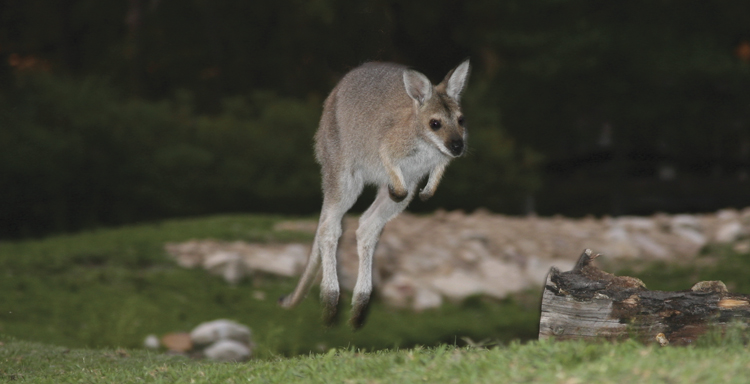As evocative of Australia as the koala, these cute-sized creatures are favourites with everyone.
Indefatiguable travellers, like the 1890s outback workers in Lawson’s famous poem, and capable of a tidy turn of speed, wallabies aren’t as fast or as powerful as their cousins the kangaroos and tend to inhabit remote, timbered or heavily-bushed areas. Some of the species have adapted to the kind of rocky terrain that goats or sheep might frequent in other parts of the world. Some have even adapted to an arboreal existence.
The wallabies that a visitor is most likely to meet are the ones most closely related to the kangaroos, and size apart, look most similar. These are the Agile Wallaby, the Red-Necked Wallaby and the shyer Swamp Wallaby.
In Australia, like many other native animals, wallabies are generally in decline. Reduced hunting pressure and actively-interventionist breed-and-release programs have slowed the decline, but generally the reduction in numbers and genetic diversity continues. The reasons for this decline are all too clear. First and foremost, competition from introduced herbivores, domestic and feral. Then those other two introduced scourges of Australian wildlife generally – foxes and feral cats. For simple proof of this: set a captive breeding population free and watch it decline. Put it behind a cat-proof and fox-proof fence on the other hand and watch it prosper. Another major factor is the fragmentation of populations due to habitat being divided by fields, fences, roads and conurbations.
The secret of their ability to travel fast and wide is in the legs. These are sprung torsion frames. When they are compressed they store energy, releasing it by returning to the original state. Like a spring. Once the animal has got going, all it needs to do is to steer, adjust for irregularities in the surface, and add the little bit of effort required to overcome the friction in the system. This explains why acceleration to a higher speed or the additional load of a large joey in the pouch has so little effect on total energy consumption.
Wallabies are of course members of that peculiar group of mammals, the marsupials. Not uniquely Australian – there are marsupials in the Americas – they are nevertheless closely identified with Australia. Young are born at a very primitive stage – a couple of weeks from conception and a couple of grams in weight - and make their way into the mother’s pouch. Once in the pouch, the young wallaby latches on to a teat, and stays attached and growing for the next several months, before it starts to investigate the outside world and become weaned on to an adult diet of grasses and leaves.
Wallabies can also suspend embryonic development. If hard times come, or an existing joey is taking all its mother’s spare energy to feed, the next foetus is kept in suspended animation until things change. The older joey might die, or just leave the pouch altogether, or times might improve. Having said that, it is not uncommon for two joeys of quite different ages to be in the pouch at the same time, and somehow the mother’s body can distinguish between the two and supply each with a different mix of nutrients.
Wallabies have done surprisingly well overseas. I remember as a small boy, on one of our regular drives south to London, being captivated by a group of wallabies that suddenly appeared out of the mist, and bounded off down the road, allowing us to follow them for quite a while before just as suddenly moving up the bank on the side of the road and disappearing through the hedge. This was England’s Peak District, relatively high and cold, and there were these gloriously exotic things, so obviously wrong for the place, yet at the same time so obviously right.
